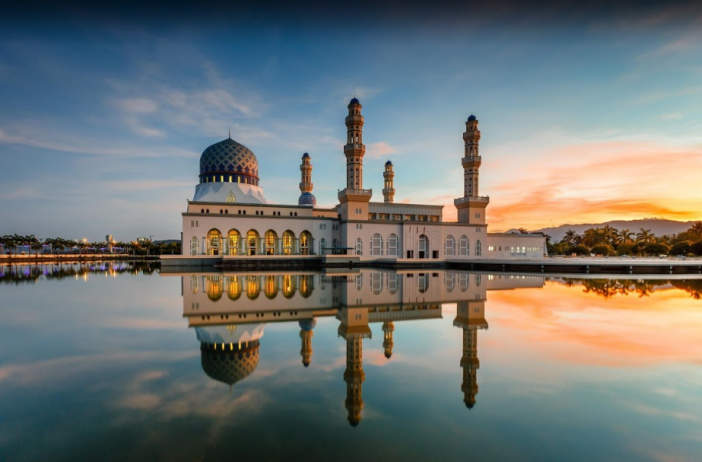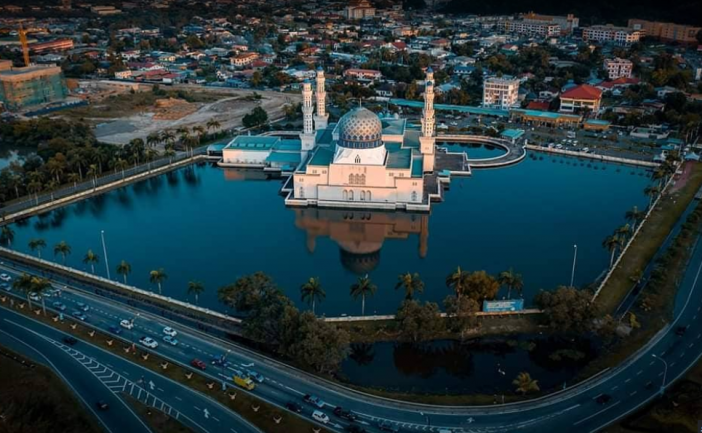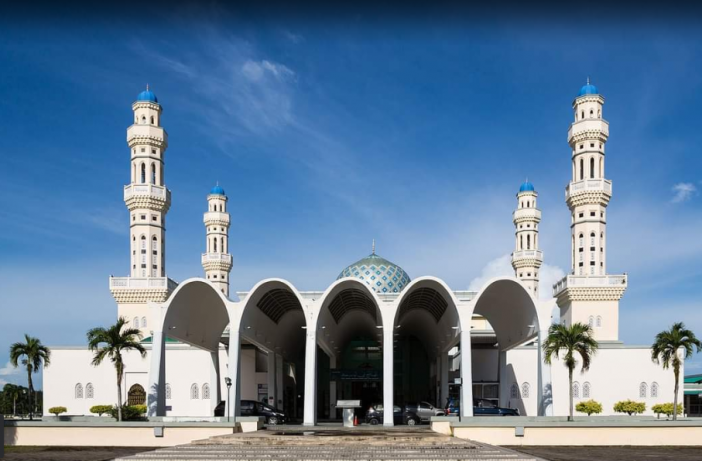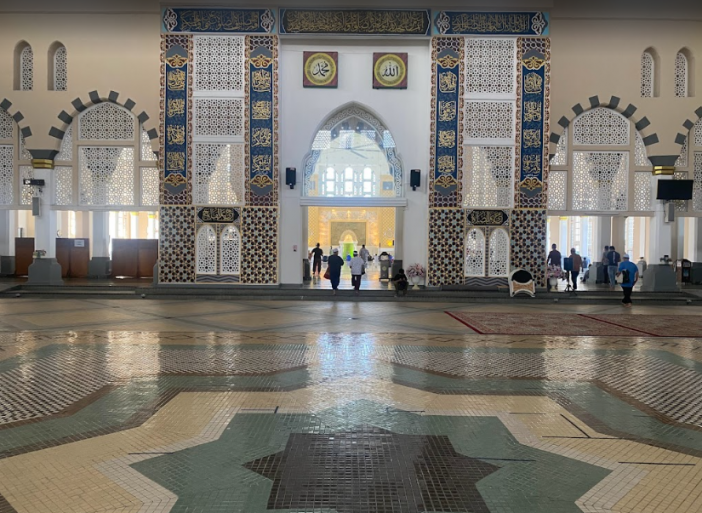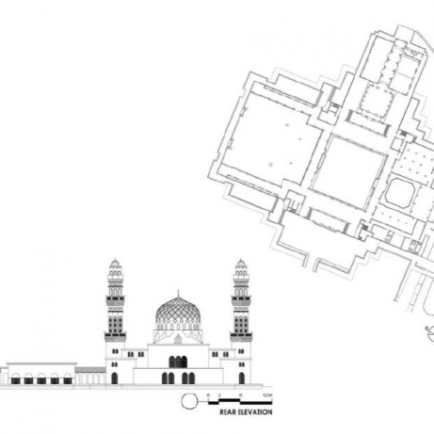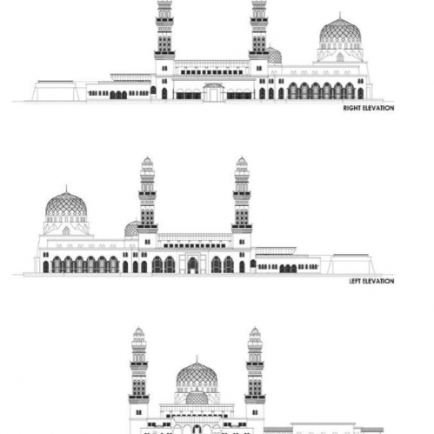Kota Kinabalu City Mosque
History
The site of Kota Kinabalu City Mosque was originally a beach and seawater shoreline of Kampung Likas.
In July 1989, the area was first covered and completed in August of the same year.
In September 1990, work to prepare the site of the mosque was started and completed in June 1991. The pile of the mosque was planted on 22 June 1992 before being completed on 23 March 1993. Financial problems have hampered the construction of the mosque until 1994.
On 18 February 2000, His Excellency Tun Datuk Seri Panglima Haji Sakaran bin Dandai as the 8th Yang di-Pertua Negeri of Sabah officiated the Kota Kinabalu City Mosque following the declaration of Kota Kinabalu as a city .
Urban and Architectural
The mosque was inspired by the architecture of Masjid Al-Nabawi in Madinah, Saudi Arabia, the mosque is noted for its sturdy structure with a high pointed dome and four identical slender minarets. Its impressive beauty is often captured in reflections on the surface of the man-made lagoon, particularly during dawn or dusk, thus earning the name of ‘the floating mosque’ amongst the locals. It also depicts the neighbouring Kampung Air enclave of Likas Bay. The construction began in 1983, when it was first coined by the then Chief Minister of Sabah. It was only completed in 2000, following many obstacles and issues faced during the construction period, which lasted some 17 years. The mosque now houses the main prayer hall, female prayer gallery, inner courtyard, library, three madrasas. An ancillary block for staff quarters and a few amenity rooms, including a preventive care clinic and ATM machines. Arranged in a linear layout, the main prayer hall is identified with the main dome that sits on modified squinches. A series of high clerestory windows and side-tucked windows give the additional appearance of the blue-checkered dome with geometrical patterns. The dome is proportionately flanked by four round minarets of the square base with three tiers vaulted balconies and surmounted with round domes.
Many windows incorporated into the design help to provide natural lighting throughout the main prayer hall. It is also preceded by the use of an inner courtyard, which has been covered and used as an overspill prayer area. Four main round columns support the main dome squinch, fronting the qibla wall with high stained-glass windows placed high above. The mihrab is placed under the stained glass windows, with the use of green granite tiles and a square frame with Islamic calligraphic inscriptions. A smaller mihrab niche with a pointed arch is centrally placed with an Imam’s prayer spot. To the far right, an elevated minbar is built with a hanging timber roof platform
Description
Kota Kinabalu City Mosque is the second major mosque built in the city of Kota Kinabalu , Sabah , Malaysia after the State Mosque. The mosque was officially opened on 18 February 2000 following the declaration of Kota Kinabalu as a city . This mosque has the characteristics of the Prophet's Mosque with almost 70 percent of the mosque area surrounded by water.
References
https://en.wikipedia.org/wiki/Kota_Kinabalu_City_Mosque
https://ms.wikipedia.org/wiki/Masjid_Bandaraya_Kota_Kinabalu
https://itc.gov.my/listings/masjid-bandaraya-kota-kinabalu/
Aziz, A. A., 2016. MASJID - Selected Mosques and Musollas in Malaysia, ATSA Architects Sdn. Bhd.
Details
الموقع
Jalan Pasir, Jalan Teluk Likas, Kampung Likas, 88400 Kota Kinabalu, Sabah, Malaysia
عدد المصليين
9000
المالك / المتبرع
Sabah Islamic Religious Council (MUIS)
المعماري
تاريخ البناء
2000
Area
12,794
الرسومات المعمارية
الخريطة
History
The site of Kota Kinabalu City Mosque was originally a beach and seawater shoreline of Kampung Likas.
In July 1989, the area was first covered and completed in August of the same year.
In September 1990, work to prepare the site of the mosque was started and completed in June 1991. The pile of the mosque was planted on 22 June 1992 before being completed on 23 March 1993. Financial problems have hampered the construction of the mosque until 1994.
On 18 February 2000, His Excellency Tun Datuk Seri Panglima Haji Sakaran bin Dandai as the 8th Yang di-Pertua Negeri of Sabah officiated the Kota Kinabalu City Mosque following the declaration of Kota Kinabalu as a city .
Urban and Architectural
The mosque was inspired by the architecture of Masjid Al-Nabawi in Madinah, Saudi Arabia, the mosque is noted for its sturdy structure with a high pointed dome and four identical slender minarets. Its impressive beauty is often captured in reflections on the surface of the man-made lagoon, particularly during dawn or dusk, thus earning the name of ‘the floating mosque’ amongst the locals. It also depicts the neighbouring Kampung Air enclave of Likas Bay. The construction began in 1983, when it was first coined by the then Chief Minister of Sabah. It was only completed in 2000, following many obstacles and issues faced during the construction period, which lasted some 17 years. The mosque now houses the main prayer hall, female prayer gallery, inner courtyard, library, three madrasas. An ancillary block for staff quarters and a few amenity rooms, including a preventive care clinic and ATM machines. Arranged in a linear layout, the main prayer hall is identified with the main dome that sits on modified squinches. A series of high clerestory windows and side-tucked windows give the additional appearance of the blue-checkered dome with geometrical patterns. The dome is proportionately flanked by four round minarets of the square base with three tiers vaulted balconies and surmounted with round domes.
Many windows incorporated into the design help to provide natural lighting throughout the main prayer hall. It is also preceded by the use of an inner courtyard, which has been covered and used as an overspill prayer area. Four main round columns support the main dome squinch, fronting the qibla wall with high stained-glass windows placed high above. The mihrab is placed under the stained glass windows, with the use of green granite tiles and a square frame with Islamic calligraphic inscriptions. A smaller mihrab niche with a pointed arch is centrally placed with an Imam’s prayer spot. To the far right, an elevated minbar is built with a hanging timber roof platform
Description
Kota Kinabalu City Mosque is the second major mosque built in the city of Kota Kinabalu , Sabah , Malaysia after the State Mosque. The mosque was officially opened on 18 February 2000 following the declaration of Kota Kinabalu as a city . This mosque has the characteristics of the Prophet's Mosque with almost 70 percent of the mosque area surrounded by water.


